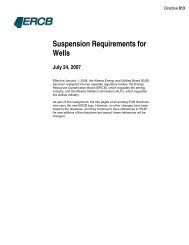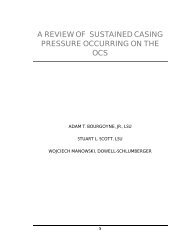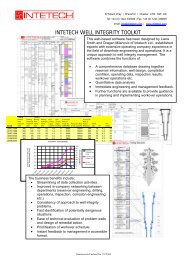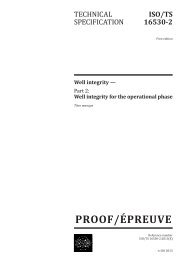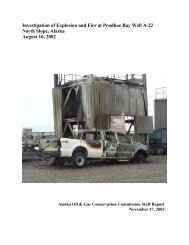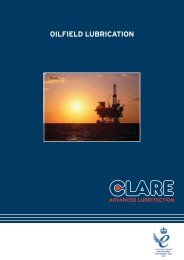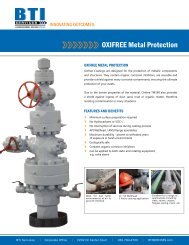Report Investigation of gas blowout on Snorre A - Well Integrity ...
Report Investigation of gas blowout on Snorre A - Well Integrity ...
Report Investigation of gas blowout on Snorre A - Well Integrity ...
Create successful ePaper yourself
Turn your PDF publications into a flip-book with our unique Google optimized e-Paper software.
7.6.2 Loss <str<strong>on</strong>g>of</str<strong>on</strong>g> buoyancy <str<strong>on</strong>g>of</str<strong>on</strong>g> the hull in c<strong>on</strong>necti<strong>on</strong> with upward flow <str<strong>on</strong>g>of</str<strong>on</strong>g> <str<strong>on</strong>g>gas</str<strong>on</strong>g><br />
Models <str<strong>on</strong>g>of</str<strong>on</strong>g> <str<strong>on</strong>g>gas</str<strong>on</strong>g> emissi<strong>on</strong>s under water show that huge emissi<strong>on</strong>s <str<strong>on</strong>g>of</str<strong>on</strong>g> <str<strong>on</strong>g>gas</str<strong>on</strong>g> are required before the<br />
percentage <str<strong>on</strong>g>of</str<strong>on</strong>g> <str<strong>on</strong>g>gas</str<strong>on</strong>g> <strong>on</strong> the surface becomes dangerous. At water depths <str<strong>on</strong>g>of</str<strong>on</strong>g> 300 meters, the <str<strong>on</strong>g>gas</str<strong>on</strong>g><br />
will spread out and <strong>on</strong>ly parts <str<strong>on</strong>g>of</str<strong>on</strong>g> the <str<strong>on</strong>g>gas</str<strong>on</strong>g> will reach the surface <str<strong>on</strong>g>of</str<strong>on</strong>g> the sea close to the facility.<br />
The extent <str<strong>on</strong>g>of</str<strong>on</strong>g> the <str<strong>on</strong>g>gas</str<strong>on</strong>g> <strong>on</strong> the surface will depend <strong>on</strong> factors such as the strength <str<strong>on</strong>g>of</str<strong>on</strong>g> the sea<br />
currents.<br />
As regards the danger <str<strong>on</strong>g>of</str<strong>on</strong>g> loss <str<strong>on</strong>g>of</str<strong>on</strong>g> buoyancy and stability <strong>on</strong> loosely moored facilities, studies<br />
by Sintef and observati<strong>on</strong>s indicate that the flow will result in a "fountain effect" that pushes<br />
facilities/vessels up and away from the area (ref. surveys and experience <strong>on</strong> Jotun, Åsgard and<br />
West Vanguard). However, this is not so simple for a tensi<strong>on</strong> leg facility like the SNA. The<br />
SNA will not be lifted up. If the SNA was pulled out, the tensi<strong>on</strong> legs would then help pull<br />
the facility back towards normal positi<strong>on</strong>. The facility would then move until equilibrium<br />
was achieved between the forces that would push it out (the <str<strong>on</strong>g>gas</str<strong>on</strong>g> stream) and the tensi<strong>on</strong> legs,<br />
which would pull it in again.<br />
In our opini<strong>on</strong>, increased tensi<strong>on</strong> in the tensi<strong>on</strong> legs as a result <str<strong>on</strong>g>of</str<strong>on</strong>g> the <str<strong>on</strong>g>gas</str<strong>on</strong>g> flow (when the<br />
dynamic link is greater than the reducti<strong>on</strong> in density) would be just as likely a scenario as loss<br />
<str<strong>on</strong>g>of</str<strong>on</strong>g> buoyancy.<br />
8 OTHER STUDIES<br />
The investigati<strong>on</strong> group's mandate calls for the group to identify the need for assistance,<br />
separate studies and the use <str<strong>on</strong>g>of</str<strong>on</strong>g> c<strong>on</strong>sultants.<br />
8.1 Need for additi<strong>on</strong>al studies<br />
The following studies are being c<strong>on</strong>sidered to further elucidate the causal relati<strong>on</strong>s <str<strong>on</strong>g>of</str<strong>on</strong>g> the<br />
incident.<br />
• Pressure resp<strong>on</strong>se, well operati<strong>on</strong>s and during well c<strong>on</strong>trol situati<strong>on</strong> for this incident<br />
• Casing wear / <strong>Well</strong> design / <strong>Well</strong> barriers<br />
• Increased buoyancy / fountain effect from the <str<strong>on</strong>g>gas</str<strong>on</strong>g> stream<br />
• Loss <str<strong>on</strong>g>of</str<strong>on</strong>g> / reduced buoyancy due to <str<strong>on</strong>g>gas</str<strong>on</strong>g> bubbles<br />
• Gas under the bucket foundati<strong>on</strong>s under various design c<strong>on</strong>diti<strong>on</strong>s<br />
• Excavati<strong>on</strong> <str<strong>on</strong>g>of</str<strong>on</strong>g> and craters in the bucket foundati<strong>on</strong>s;<br />
• Loss <str<strong>on</strong>g>of</str<strong>on</strong>g> sucti<strong>on</strong> under the bucket foundati<strong>on</strong>s in the event <str<strong>on</strong>g>of</str<strong>on</strong>g> cracking or damage.<br />
9 ABBREVIATIONS<br />
AR Activity requirement<br />
B&B Drilling and wells<br />
BOP Blow out preventer<br />
CCR Central C<strong>on</strong>trol Room<br />
HAZOP hazard and operability study (Risk analysis)<br />
LEL Lower Explosi<strong>on</strong> Limit<br />
mMD meters Measured Depth<br />
48



